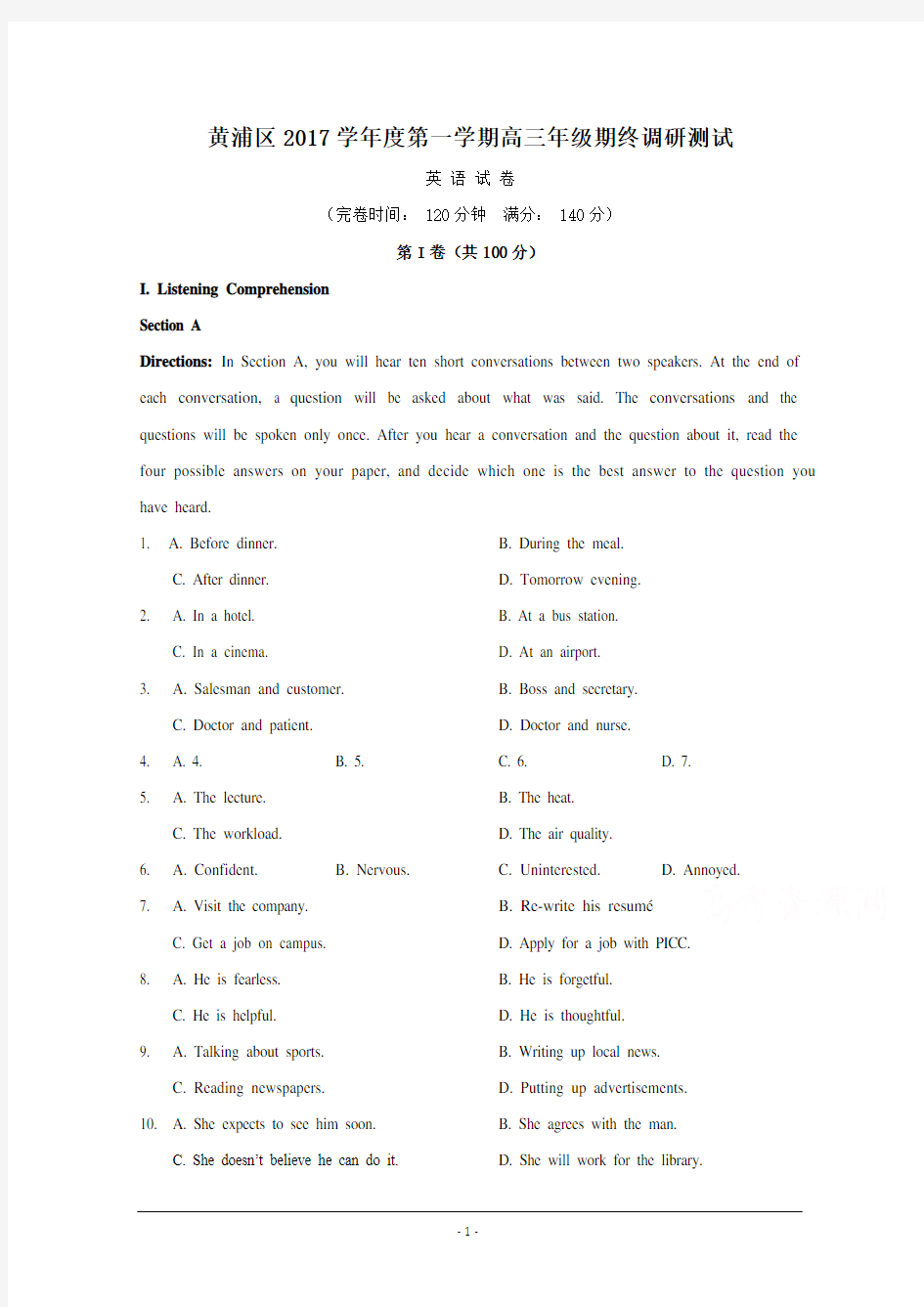
2018上海黄浦区高三一模英语试题及答案
- 格式:doc
- 大小:582.78 KB
- 文档页数:14


黄浦区2017学年度第一学期高三年级期终调研测试
英语试卷
(完卷时间: 120分钟满分: 140分)
第I卷(共100分)
I. Listening Comprehension
Section A
Directions: In Section A, you will hear ten short conversations between two speakers. At the end of each conversation, a question will be asked about what was said. The conversations and the questions will be spoken only once. After you hear a conversation and the question about it, read the four possible answers on your paper, and decide which one is the best answer to the question you have heard.
1. A. Before dinner. B. During the meal.
C. After dinner.
D. Tomorrow evening.
2. A. In a hotel. B. At a bus station.
C. In a cinema.
D. At an airport.
3. A. Salesman and customer. B. Boss and secretary.
C. Doctor and patient.
D. Doctor and nurse.
4. A. 4. B.
5. C.
6. D.
7.
5. A. The lecture. B. The heat.
C. The workload.
D. The air quality.
6. A. Confident. B. Nervous. C. Uninterested. D. Annoyed.
7. A. Visit the company. B. Re-write his resumé.
C. Get a job on campus.
D. Apply for a job with PICC.
8. A. He is fearless. B. He is forgetful.
C. He is helpful.
D. He is thoughtful.
9. A. Talking about sports. B. Writing up local news.
C. Reading newspapers.
D. Putting up advertisements.
10. A. She expects to see him soon. B. She agrees with the man.
C. She doesn’t believe he can do it.
D. She will work for the library.
Section B
Directions: In Section B, you will hear one longer conversation and two short passages. After each conversation or passage, you will be asked several questions. The conversation and the passages will be read twice, but the questions will be spoken only once. When you hear a question, read the four possible answers on your paper and decide which one would be the best answer to the question you have heard.
Questions 11 through 14 are based on the following conversation.
11. A. The scientific steps to write a paper. B. A funny story that they read recently.
C. An assignment of a creative writing course.
D. A detective case that was just finished.
12. A. She encountered a bottleneck when writing a story.
B. She was happy that she finished the story easily.
C. She was expected to finish the story in a month.
D. She decided to give up the story eventually.
13. A. Change to another topic. B. Give the story an ending first.
C. Do work for another course.
D. Write everything occurring to her.
14. A. Buy jewels for her mother. B. Locate the security camera.
C. Do some research for her writing.
D. Rob a jewelry store for ideas.
Questions 15 through 17 are based on the following passage.
15. A. They don’t attach importance to scores. B. They attract fewer and fewer students.
C. They will take place next week.
D. They will no longer exist.
16. A. To inspire young people to practice more.
B. To encourage young people to be creative.
C. To motivate young people to keep learning.
D. To urge young people to start up companies.
17. A. To bring more economic benefits. B. To help students memorize better.
C. To change the present education system.
D. To develop teachers’ multi-skills. Questions 18 through 20 are based on the following passage.